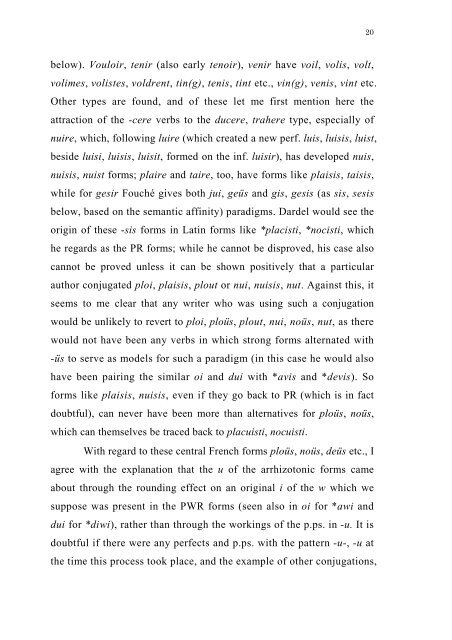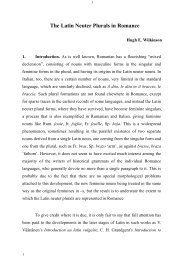THE STRONG PERFECTS IN THE ROMANCE ... - Page ON
THE STRONG PERFECTS IN THE ROMANCE ... - Page ON
THE STRONG PERFECTS IN THE ROMANCE ... - Page ON
Create successful ePaper yourself
Turn your PDF publications into a flip-book with our unique Google optimized e-Paper software.
elow). Vouloir, tenir (also early tenoir), venir have voil, volis, volt,<br />
volimes, volistes, voldrent, tin(g), tenis, tint etc., vin(g), venis, vint etc.<br />
Other types are found, and of these let me first mention here the<br />
attraction of the -cere verbs to the ducere, trahere type, especially of<br />
nuire, which, following luire (which created a new perf. luis, luisis, luist,<br />
beside luisi, luisis, luisit, formed on the inf. luisir), has developed nuis,<br />
nuisis, nuist forms; plaire and taire, too, have forms like plaisis, taisis,<br />
while for gesir Fouché gives both jui, geüs and gis, gesis (as sis, sesis<br />
below, based on the semantic affinity) paradigms. Dardel would see the<br />
origin of these -sis forms in Latin forms like *placisti, *nocisti, which<br />
he regards as the PR forms; while he cannot be disproved, his case also<br />
cannot be proved unless it can be shown positively that a particular<br />
author conjugated ploi, plaisis, plout or nui, nuisis, nut. Against this, it<br />
seems to me clear that any writer who was using such a conjugation<br />
would be unlikely to revert to ploi, ploüs, plout, nui, noüs, nut, as there<br />
would not have been any verbs in which strong forms alternated with<br />
-üs to serve as models for such a paradigm (in this case he would also<br />
have been pairing the similar oi and dui with *avis and *devis). So<br />
forms like plaisis, nuisis, even if they go back to PR (which is in fact<br />
doubtful), can never have been more than alternatives for ploüs, noüs,<br />
which can themselves be traced back to placuisti, nocuisti.<br />
With regard to these central French forms ploüs, noüs, deüs etc., I<br />
agree with the explanation that the u of the arrhizotonic forms came<br />
about through the rounding effect on an original i of the w which we<br />
suppose was present in the PWR forms (seen also in oi for *awi and<br />
dui for *diwi), rather than through the workings of the p.ps. in -u. It is<br />
doubtful if there were any perfects and p.ps. with the pattern -u-, -u at<br />
the time this process took place, and the example of other conjugations,<br />
20









